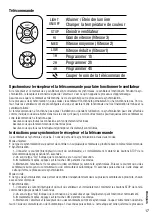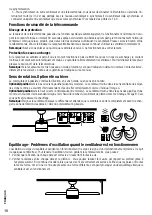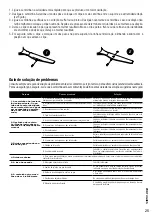
13
ENGLISH
If you have completed the previous steps and the wobbling has not resolved, you should apply dynamic balancing with the
kit provided, as explained below:
1. Turn the fan on to the highest speed so that the greatest amount of wobbling is produced.
2. Turn off the fan. Select a blade and place a clip on it (see diagram) halfway between the fastening and the far edge of the
blade.
3. Turn on the fan and check whether the wobbling has improved or gotten worse. Turn it off once again and if the wobbling
has not improved, place the clip on another blade. Repeat this process and determine on which blade it improves the
wobbling.
4. Leave the clip on the blade that produces the best results. Move the clip forward or backwards on this blade until finding
the position that offers the best results.
5. Afterwards, remove the clip and place one of the weights on the upper part of the center line of the blade at the position
where the clip was located.
1
2
Troubleshooting guide
Always consult this troubleshooting guide before contacting the technical service to avoid potentially unnecessary charges.
For your safety, ensure that the fan is not connected to power before attempting the solutions suggested in this troubleshoo-
ting guide.
Symptom
Probable causes
Solution
1. The fan does not work
(Important notice: The device
must be disconnected from
the power supply and the as-
sistance of a certified electri-
cian may be necessary)
A. The fuse is blown or the switch is “open”, disconnecting the
power supply to the device
Check the fuses and switches on the device installation power circuit
B. System wiring connections are not adequately tightened
Check that wiring connections have been done correctly. They must
be carried out by a certified electrician
.
C. The remote control is unresponsive
Replace the remote control battery if necessary. Otherwise, resyn-
chronize the transmitter and receiver.
D. No power supply
Check that the system has power and that it reaches the device.
2. Fan wobbling (follow the
instructions in the “Wobbling”
section of this manual)
A. The fan blades are not parallel to the ceiling
Follow the instructions indicated in the “Balancing” section of this
manual.
B. Blade fastening screws are loose
Follow the instructions indicated in the “Balancing” section of this
manual.
C. Deformed blades
Follow the instructions indicated in the “Balancing” section of this
manual
.
3. Excessive noise when the
fan moves
A. Upper canopy is touching the ceiling
Lower the upper canopy, ensuring a separation from the ceiling of
no less than 3 mm.
B. Blade fastening screws are loose
Tighten all fastening screws once again (but not excessively)
C. Ceiling mounting is loose
Retighten all ceiling mount screws
D. Incorrect remote control
Replace the remote control with that provided with the device. This
must be supervised by a certified electrician. Contact the distributor
4. Mechanical noise
A. If this is the first use, leave the fan on for at least 8 hours. In the event that mechanical noise continues after this period, contact
the technical service
5. The lights does not turn on
A. The light is defective
Replace the light
6. The fan turns but the air-
flow is inadequate
A. Incorrect blade rotation direction
The blades may be rotating in the opposite direction. Follow the di-
rections in the “Rotation Direction” section of this manual.
B. Inadequate distance between the ceiling and blades
Installing a fan without a shaft, flush with the ceiling, can reduce
airflow.
C. Existence of nearby objects
There may exist objects in the room that block airflow.
D. Inadequate blade diameter
The fan chosen may be too small for the volume of the room where
it is installed














































